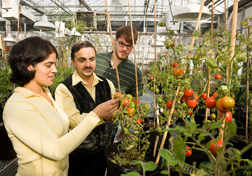Using Genetics To Build a Better Tomato
Agricultural Research Service researchers are working to save our tomatoes—or at least some of them.
Tomatoes spend so much time on shelves and in refrigerators that an estimated 20 percent are lost to spoilage, according to the USDA Economic Research Service. Autar Mattoo, an ARS plant physiologist with the Sustainable Agricultural Systems Laboratory in Beltsville, Maryland, is trying to change that. Mattoo is working with Avtar Handa, a professor of horticulture at Purdue University, to enhance tomatoes so that they offer not only better taste and higher nutrient levels, but also a longer shelf life.
Mattoo, Handa, and Savithri Nambeesan, a graduate student working with Handa, recently focused on manipulating a class of nitrogen-based organic compounds known as “polyamines” that act as signals and play a role in the plant’s growth, flowering, fruit development, ripening, and other functions. Polyamines have also been linked to the production of lycopene and other nutrients that lower our risk of developing certain cancers and other diseases, making them a prime target for investigation, according to Mattoo.
“We wanted to see if we could increase the levels of polyamines in tomatoes and then investigate their biological effects,” Mattoo says.
The researchers introduced a yeast gene, known as “spermidine synthase,” into tomato plants specifically to increase production of a single polyamine—spermidine. Spermidine is found in all biological organisms and is one of three polyamines believed to modulate the plant-ripening process.
The results, published in The Plant Journal, showed that introducing the gene not only increased spermidine levels and vegetative growth, but also significantly extended the tomato’s postharvest shelf life. Shriveling was delayed by up to 3 weeks, and there was a slower rate of decay caused by tomato plant diseases. The tomatoes also had higher levels of the antioxidant lycopene. The study shows for the first time that spermidine has its own effects, independent of the other polyamines, extending shelf life and increasing growth. Polyamines are found in other plants, so the work could assist in efforts designed to extend the postharvest shelf life of other crops.
“We know that in tomato fruit, the signaling machinery continues to function late into the ripening process. By designing genes that would lead to higher levels of polyamines, it should be possible to modulate ripening and influence nutrient levels as well,” says Mattoo.
The use of molecular genetics to enhance tomatoes has faced some resistance from consumers and industry. But scientists have used such molecular techniques for years to develop improved varieties of corn, soybeans, and cotton, and Mattoo is confident that in time the approach will become more widely accepted as its benefits are better understood.—By Dennis O'Brien, Agricultural Research Service Information Staff.
This research is part of Plant Biological and Molecular Processes, an ARS national program (#302) described at www.nps.ars.usda.gov.
Autar Mattoo is with the USDA-ARS Sustainable Agricultural Systems Laboratory, 10300 Baltimore Ave., Bldg. 001, Room 119, Beltsville, MD 20705-2350; (301) 504-6622.
"Using Genetics To Build a Better Tomato" was published in the February 2011 issue of Agricultural Research magazine.







